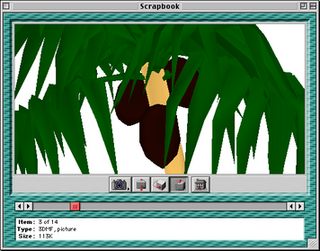Related Research Articles

Microsoft DirectX is a collection of application programming interfaces (APIs) for handling tasks related to multimedia, especially game programming and video, on Microsoft platforms. Originally, the names of these APIs all began with "Direct", such as Direct3D, DirectDraw, DirectMusic, DirectPlay, DirectSound, and so forth. The name DirectX was coined as a shorthand term for all of these APIs and soon became the name of the collection. When Microsoft later set out to develop a gaming console, the X was used as the basis of the name Xbox to indicate that the console was based on DirectX technology. The X initial has been carried forward in the naming of APIs designed for the Xbox such as XInput and the Cross-platform Audio Creation Tool (XACT), while the DirectX pattern has been continued for Windows APIs such as Direct2D and DirectWrite.
DirectDraw (ddraw.dll) is an API that used to be a part of Microsoft's DirectX API. DirectDraw is used to accelerate rendering of 2D graphics in applications. DirectDraw also allows applications to run fullscreen or embedded in a window such as most other MS Windows applications. DirectDraw uses hardware acceleration if it is available on the client's computer. DirectDraw allows direct access to video memory, hardware overlays, hardware blitters, and page flipping. Its video memory manager can manipulate video memory with ease, taking full advantage of the blitting and color decompression capabilities of different types of display adapters.
Direct3D is a graphics application programming interface (API) for Microsoft Windows. Part of DirectX, Direct3D is used to render three-dimensional graphics in applications where performance is important, such as games. Direct3D uses hardware acceleration if it is available on the graphics card, allowing for hardware acceleration of the entire 3D rendering pipeline or even only partial acceleration. Direct3D exposes the advanced graphics capabilities of 3D graphics hardware, including Z-buffering, W-buffering, stencil buffering, spatial anti-aliasing, alpha blending, color blending, mipmapping, texture blending, clipping, culling, atmospheric effects, perspective-correct texture mapping, programmable HLSL shaders and effects. Integration with other DirectX technologies enables Direct3D to deliver such features as video mapping, hardware 3D rendering in 2D overlay planes, and even sprites, providing the use of 2D and 3D graphics in interactive media ties.
Fahrenheit was an effort to create a unified high-level API for 3D computer graphics to unify Direct3D and OpenGL. It was designed primarily by Microsoft and SGI and also included work from an HP-MS joint effort.
Magnetic Scrolls was a British video game developer active between 1984 and 1990. A pioneer of audiovisually elaborate text adventure games, it was one of the largest and most acclaimed interactive fiction developers of the 1980s, and one of the "Big Two" with Infocom according to some.

QuickDraw 3D, or QD3D for short, is a 3D graphics API developed by Apple Inc. starting in 1995, originally for their Macintosh computers, but delivered as a cross-platform system.

DirectShow, codename Quartz, is a multimedia framework and API produced by Microsoft for software developers to perform various operations with media files or streams. It is the replacement for Microsoft's earlier Video for Windows technology. Based on the Microsoft Windows Component Object Model (COM) framework, DirectShow provides a common interface for media across various programming languages, and is an extensible, filter-based framework that can render or record media files on demand at the request of the user or developer. The DirectShow development tools and documentation were originally distributed as part of the DirectX SDK. Currently, they are distributed as part of the Windows SDK.
RenderWare is a video game engine developed by British game developer Criterion Software.
Game programming, a subset of game development, is the software development of video games. Game programming requires substantial skill in software engineering and computer programming in a given language, as well as specialization in one or more of the following areas: simulation, computer graphics, artificial intelligence, physics, audio programming, and input. For multiplayer games, knowledge of network programming is required. In some genres, e.g. fighting games, advanced network programming is often demanded, as the netcode and its properties are considered by players and critics to be some of the most important metrics of the game's quality. For massively multiplayer online games (MMOGs), even further knowledge of database programming and advanced networking programming are required. Though often engaged in by professional game programmers, there is a thriving scene of independent developers who lack a relationship with a publishing company.
Direct3D and OpenGL are both application programming interfaces (APIs) that can be used in applications to render 2D and 3D computer graphics. As of 2005, graphics processing units (GPUs) almost always implement one version of both of these APIs. Examples include: DirectX 9 and OpenGL 2 circa 2004; DirectX 10 and OpenGL 3 circa 2008; and most recently, DirectX 11 and OpenGL 4 circa 2011. GPUs that support more recent versions of the standards are backwards compatible with applications that use the older standards; for example, one can run older DirectX 9 games on a more recent DirectX 11-certified GPU.
In computing, D3DX is a high level API library which is written to supplement Microsoft's Direct3D graphics API. The D3DX library was introduced in Direct3D 7, and subsequently was improved in Direct3D 9. It provides classes for common calculations on vectors, matrices and colors, calculating look-at and projection matrices, spline interpolations, and several more complicated tasks, such as compiling or assembling shaders used for 3D graphic programming, compressed skeletal animation storage and matrix stacks. There are several functions that provide complex operations over 3D meshes like tangent-space computation, mesh simplification, precomputed radiance transfer, optimizing for vertex cache friendliness and strip reordering, and generators for 3D text meshes. 2D features include classes for drawing screen-space lines, text and sprite based particle systems. Spatial functions include various intersection routines, conversion from/to barycentric coordinates and bounding box and sphere generators.

PhysX is an open-source realtime physics engine middleware SDK developed by Nvidia as a part of Nvidia GameWorks software suite.
Desktop Window Manager is the compositing window manager in Microsoft Windows since Windows Vista that enables the use of hardware acceleration to render the graphical user interface of Windows.
A graphics library is a program library designed to aid in rendering computer graphics to a monitor. This typically involves providing optimized versions of functions that handle common rendering tasks. This can be done purely in software and running on the CPU, common in embedded systems, or being hardware accelerated by a GPU, more common in PCs. By employing these functions, a program can assemble an image to be output to a monitor. This relieves the programmer of the task of creating and optimizing these functions, and allows them to focus on building the graphics program. Graphics libraries are mainly used in video games and simulations.
HOOPS Visualize is a 3D computer graphics software designed to render graphics across both mobile and desktop platforms. HOOPS Visualize provides 3D Graphics API to render CAD models. It's part of the HOOPS 3D Application Framework SDK. Since June 2018 it's licensed via Siemens PLM Software.
Qube Software is a British company specialising in advanced 3D technology. It was founded in 1998 by Servan Keondjian, Hugh Steers, and Doug Rabson who created the Reality Lab renderer and who subsequently played a leading role at Microsoft turning it into Direct3D.
Q is a 3D engine / tech development platform / interoperability standard developed by the London-based developer Qube Software.

WebGL is a JavaScript API for rendering interactive 2D and 3D graphics within any compatible web browser without the use of plug-ins. WebGL is fully integrated with other web standards, allowing GPU-accelerated usage of physics, image processing, and effects in the HTML canvas. WebGL elements can be mixed with other HTML elements and composited with other parts of the page or page background.

GPUOpen is a middleware software suite originally developed by AMD's Radeon Technologies Group that offers advanced visual effects for computer games. It was released in 2016. GPUOpen serves as an alternative to, and a direct competitor of Nvidia GameWorks. GPUOpen is similar to GameWorks in that it encompasses several different graphics technologies as its main components that were previously independent and separate from one another. However, GPUOpen is partially open source software, unlike GameWorks which is proprietary and closed.
References
- 1 2 "Reality Lab: fast 3D for games developers". NEXT Generation . February 1995. Retrieved 2022-08-28.
- ↑ Qube Software - Servan Keondjian and Doug Rabson founded Qube after leaving Microsoft.
- ↑ Crushed By Microsoft
- ↑ DeMaria, Rusel (2019). "12. 3D Wars". GAME OF X V.2. CRC Press.
- ↑ Ozer, Jan; Seltzer, Larry (December 5, 1995). "Using Windows 95's Direct SDK Access". PC Magazine . Retrieved 2022-08-28.
- Drummond, Michael (November 2000). Renegades of the Empire: How Three Software Warriors Started a Revolution Behind the Walls of Fortress Microsoft . California: Three Rivers Press. ISBN 978-0-609-80745-3. Covers the early years of DirectX development within Microsoft, including the acquisition of RenderMorphics.